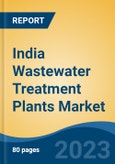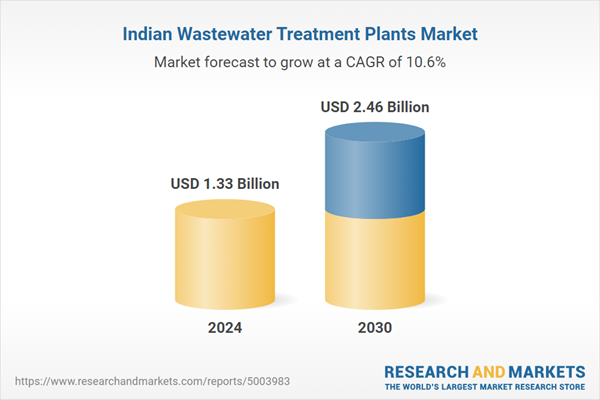Speak directly to the analyst to clarify any post sales queries you may have.
10% Free customizationThis report comes with 10% free customization, enabling you to add data that meets your specific business needs.
With the country facing escalating water scarcity and pollution challenges, the need for efficient wastewater treatment solutions has become paramount. The government’s stringent regulatory framework and initiatives, such as the Namami Gange Mission and Smart Cities Mission, have further accelerated the deployment of wastewater treatment plants across the country. These programs aim to address the dual objectives of conserving water resources and mitigating the impact of untreated sewage on ecosystems.
The market benefits from a diverse customer base, including municipalities, industries, and commercial establishments. Municipal wastewater treatment plants dominate the market, addressing the needs of urban centers struggling with rising populations and inadequate sewage infrastructure. On the industrial front, sectors such as pharmaceuticals, chemicals, textiles, and food and beverage are significant contributors to the market, given their high wastewater generation and compliance requirements. Companies are increasingly adopting advanced treatment technologies, such as membrane bioreactors (MBR), activated sludge processes, and anaerobic digestion systems, to achieve higher treatment efficiencies and meet regulatory standards.
Key Market Drivers
Urbanization and Population Growth
India’s rapid urbanization and population growth are key drivers for the wastewater treatment plants market. As urban areas expand, the demand for reliable water management systems increases exponentially. The burgeoning population in cities leads to significant wastewater generation, creating a pressing need for treatment infrastructure. According to world bank, by 2036, India’s urban population is projected to exceed 600 million, increasing the demand for wastewater treatment infrastructure. This rapid urbanization contributes to a rise in municipal wastewater generation, requiring advanced treatment solutions to meet growing urban water demands and sanitation needs.This demand has prompted investments in modern wastewater treatment plants to address the inadequacies of urban sewage systems. Municipalities are partnering with private companies to implement advanced solutions, such as decentralized treatment units and smart monitoring systems. Additionally, smart city initiatives emphasize sustainable water and wastewater management, further boosting market opportunities. Treated water reuse for landscaping, industrial processes, and public amenities is gaining traction, making wastewater treatment an essential component of urban planning.
Key Market Challenges
High Capital and Operational Costs
The India Wastewater Treatment Plants market faces the significant challenge of high capital and operational costs, which can deter widespread adoption. Establishing a wastewater treatment plant requires substantial investment in infrastructure, equipment, and skilled labor. Advanced technologies like membrane bioreactors (MBR) and reverse osmosis (RO) systems, while highly efficient, come with elevated costs that are often unaffordable for smaller municipalities and industries. Additionally, operational expenses such as energy consumption, chemical usage, and regular maintenance add to the financial burden. For many stakeholders, particularly in Tier II and Tier III cities, the lack of access to affordable financing options exacerbates the problem.Key Market Trends
Growing Demand for Wastewater Reuse
India is experiencing a rising demand for wastewater reuse across various sectors, driven by water scarcity and the need for sustainable resource management. Treated wastewater is increasingly being used for applications such as industrial cooling, irrigation, and even groundwater recharge, reducing dependence on freshwater sources. The agricultural sector, which consumes a significant portion of India’s water resources, is a major beneficiary of this trend. Treated wastewater, rich in nutrients, serves as an alternative irrigation source, promoting sustainable farming practices.Industrial sectors, particularly power plants, chemical manufacturers, and textiles, are also adopting wastewater reuse to mitigate water risks and comply with stricter environmental regulations. Municipalities are investing in large-scale wastewater reuse projects to cater to urban non-potable water demands. Cities like Chennai and Bengaluru are leading the way by utilizing treated wastewater for landscape irrigation, construction, and other non-potable purposes.
Additionally, state governments are incentivizing industries and local bodies to implement wastewater recycling systems through subsidies and policy support. This trend has spurred the development of advanced water treatment technologies, including reverse osmosis (RO), ultrafiltration (UF), and nanofiltration (NF), to ensure that treated wastewater meets stringent quality standards. As India grapples with a growing water crisis, wastewater reuse is expected to play a pivotal role in achieving water security and sustainability.
Key Market Players
- VA Tech Wabag Limited
- Thermax Limited
- Ion Exchange (India) Limited
- Doshion Private Limited
- Veolia India Private Limited
- Nalco Water India Private Limited
- Larsen And Toubro Limited
- Triveni Engineering And Industries Limited
- Paramount Limited
Report Scope:
In this report, the India Wastewater Treatment Plants Market has been segmented into the following categories, in addition to the industry trends which have also been detailed below:India Wastewater Treatment Plants Market, By Type:
- Municipal
- Industrial
India Wastewater Treatment Plants Market, By Plant Category:
- Less Than 50 MLD
- 51-100 MLD
- 101-200 MLD
- 201-500 MLD
- Above 501
India Wastewater Treatment Plants Market, By Process:
- Moving Bed Biological Reactor (MBBR)
- Sequencing Batch Reactor (SBR)
India Wastewater Treatment Plants Market, By Operating Mode:
- EPC
- BOO
- BOOT
India Wastewater Treatment Plants Market, By End User Industry:
- Refineries
- Pharmaceuticals
- Power
- Steel
- Chemicals
- Paper & Pulp
- Sugar
- Textile
- Others
India Wastewater Treatment Plants Market, By Region:
- North India
- South India
- West India
- East India
Competitive Landscape
Company Profiles: Detailed analysis of the major companies present in the India Wastewater Treatment Plants Market.Available Customizations:
With the given market data, the publisher offers customizations according to a company's specific needs. The following customization options are available for the report.Company Information
- Detailed analysis and profiling of additional market players (up to five).
This product will be delivered within 1-3 business days.
Table of Contents
Samples

LOADING...
Companies Mentioned
- VA Tech Wabag Limited
- Thermax Limited
- Ion Exchange (India) Limited
- Doshion Private Limited
- Veolia India Private Limited
- Paramount Limited
- Nalco Water India Private Limited
- Larsen And Toubro Limited
Table Information
| Report Attribute | Details |
|---|---|
| No. of Pages | 88 |
| Published | March 2025 |
| Forecast Period | 2024 - 2030 |
| Estimated Market Value ( USD | $ 1.33 Billion |
| Forecasted Market Value ( USD | $ 2.46 Billion |
| Compound Annual Growth Rate | 10.6% |
| Regions Covered | India |
| No. of Companies Mentioned | 8 |









